#Nummulites fossil
Explore tagged Tumblr posts
Photo

Nummulitic Limestone Fossil – Eocene Foraminifera, Clues de Barles France, Authentic Specimen
An exceptional piece of Nummulitic Limestone containing abundant fossil foraminifera from the Eocene Epoch (~40–50 million years ago). This specimen originates from the fossil-rich locality of Clues de Barles in the Haute-Provence region of southeastern France.
The dominant fossils in this rock are Nummulites, large, disc-shaped benthic foraminifera that thrived in warm, shallow marine environments. These organisms were important contributors to carbonate sedimentation in the Eocene and played a significant role in reef and platform development.
Fossil Type: Foraminifera (Marine Microfossils)
Primary Genus: Nummulites
Geological Age: Eocene – Lutetian to Bartonian Stages
Formation: Nummulitic Limestone Beds (Alpine foreland basin sediments)
Depositional Environment: Formed in warm, shallow marine carbonate platform settings. Rich in calcareous micro- and macrofossils, this environment supported diverse benthic communities and accumulated thick deposits of bioclastic limestone.
Morphological Features:
Disc-like, coin-shaped foraminiferal tests (shells)
Radial and concentric internal chamber structure
Dense fossil concentration in fine-grained matrix
Notable:
Classic and scientifically significant fossiliferous limestone
Sourced from a world-famous geological and fossil site in southern France
Excellent educational, display, or geological reference piece
The exact specimen photographed is the one you will receive
Authenticity: All of our fossils are 100% genuine natural specimens and come with a Certificate of Authenticity. Please refer to the photo and scale cube (1cm squares) for accurate sizing.
This slab of Nummulitic Limestone from Clues de Barles offers a stunning glimpse into Eocene marine life and the geological processes of carbonate formation. A classic fossil collectible with both scientific and visual appeal.
#Nummulites fossil#foraminifera limestone#Eocene fossil France#Clues de Barles fossil#fossil limestone#nummulitic rock#fossil marine microfauna#French fossil stone#foraminiferal fossil#fossil collector slab#fossil limestone France#authentic fossil specimen
0 notes
Text

The Great Sphinx
Who Built the Sphinx? The Sphinx Temple Has the Answer by Mark Lehner
Many alternative thinkers claim the Sphinx is much, much older, that it existed thousands of years before Khufu. But our study of the Sphinx and the temple lying just below it—the Sphinx Temple—says no. As certain as we can be about such matters, Khafre created most of the Sphinx. However, Khufu might have started it.
The stone-by-stone map of the Sphinx Temple allowed us to investigate a telltale clue about who built the Sphinx. Quarrymen cut the core blocks (the ones forming the core of the temple walls) so thick—some weigh up to a hundred tons—that many of them include three geological layers. And it was clear that the layers in many blocks were the same as those that run through the bedrock of the Sphinx itself. The blocks had to have come from the U-shaped ditch around the Sphinx. When workers quarried the ditch they left a large block of limestone from which the Sphinx was carved.
As I moved about the Sphinx Temple during my first year of the mapping project, I was struck by how the geological layers run continuously in many places, from one block to another, as the layers must have run in the bedrock. The gangs of young men who moved these mighty stones did not have much chance of mixing them up from quarry to temple wall. The Sphinx and its temple must have been part of the same quarry-construction sequence. But could I prove this?
The following year I met Tom, who had the expertise needed to geologically “fingerprint” the blocks and trace them back to the quarry. Tom looked at the Giza Plateau less as an archaeological site and more as frozen sea floors, petrified, pancaked, and stacked into the bedrock layers from which the pyramid builders quarried blocks, created tombs, and carved the Sphinx.
These layers formed during the Eocene epoch—some 34 to 56 million years ago, as a great primordial sea retreated northward. Under its ebbing waters, a colossal bank of nummulites, unicellular plankton-like organisms, built up. A sandbar developed on the embankment, and in the more protected waters behind it, a shoal and coral reef grew. As the sea retreated to the north, the area behind the sand bank became a muddy lagoon, inhabited by burrowing bivalves and sea urchins. A regular sequence accumulated, which petrified as soft, yellow, marly layers interspersed with harder beds.
In carving the Sphinx directly from the natural rock, the ancient Egyptian quarrymen cut a cross-section through the principal geological layers of the southeastern slope of the Moqattam Formation. The hard layers of the shoal and reef, for example, make up the lowest layer in the Sphinx and its ditch.
Tom and I began our Sphinx Temple core block study by examining each layer, or bed, of the Sphinx. We gave each bed a number and marked them on photographs and on profiles of the Sphinx. The beds were easy to distinguish as they weathered differentially: harder beds protruded, softer beds receded. Also, the relative abundance of different fossils varied. Members I and II showed the greatest differences: I is a very hard gray reef formation, while the first bed of Member II, 2b, is one of the softest of the yellow marl-clay layers. Members II and III are distinct, but the boundary is not so clear as between I and II. Aigner, following an earlier geologist, set the boundary between Beds 7 and 8.
The massive fine-grained bedrock of Beds 8–9 made for good sculpting, with far more endurance than the soft-hard-soft sequence of Member II. This is why the 4th Dynasty builders reserved Member III for the more exposed head. Details like the eyebrows have survived wind, rain, and sand for 4,500 years.
But from which beds exactly did they cut the core blocks? Would this tell us where they were in fashioning the Sphinx at the time they built the Sphinx Temple? To answer these questions we logged each block. We recorded their lithic qualities and fossil content, and assigned each block to one of seven types, A through G.
Most of the Sphinx Temple core blocks are Type A and consist of three layers: upper and lower hard massive layers separated by the soft, yellow marl layer in the middle, which runs continuously through separate blocks over long stretches of temple wall. These blocks come from beds that correspond to the lower chest of the Sphinx.
Type C blocks come from beds that correspond to the Sphinx’s upper chest, top of the chest, and base of the neck. In the Sphinx Temple these blocks cluster near the front. The quarry workers hewed the blocks from layers that would become the lion’s upper chest and top of the back and then dragged them to the eastern front of the Sphinx Temple. As quarry workers cut deeper, to the middle and lower Sphinx chest level, haulers and builders composed most of the core walls of the temple.
Block types B and D did not come from the Sphinx ditch. They most closely match strata to the southwest, exposed in the quarry cut for the Khentkawes Monument. They are less frequent and more intermittent in the temple walls than the A and C blocks. This could indicate that the builders stockpiled these blocks and brought them into the walls whenever there was a hiatus in the quarrying, dragging, and placing of the A blocks from the Sphinx ditch.
Khafre’s workers started shaping the Sphinx as they built his valley temple. And they were probably still shaping the lower lion body, cutting it out of its surrounding ditch, as they made the Sphinx Temple, Khafre’s last major addition to his pyramid complex. But they did not finish. They left the Sphinx Temple incomplete, without its exterior granite casing.
#ancient egypt#kemet#kemetic#egypt#pharaonic#Great Sphinx of Giza#seven wonders of the ancient world#Khufu#Khafre
118 notes
·
View notes
Text


I have made a POKEMON for a project with @napnapcakes :3
Spirell (Spiral, Spell, Shell)
The Spiral Shell Pokemon
Rock/Fairy Type
Ability:
Benthic: Powers up Water-type moves.
Height: 3'07" / 1.1 m
Weight: 225.7 lbs / 497.6 kg
It's a fossil Pokemon based loosely on Nummulites, a foraminiferan. They were roughly coin sized (give or take) and lens-shaped, and fossilized in a metric fuckton of southwest Asia/the Mediterranean's limestone. The inside of these fossils has beautiful, rope-like spiral shapes.
I'm pretty sure the spiral shape didn't show on the outside for Nummulites, but it was what drew me to them, so I took creative liberties with it to make Spirell more interesting-looking. And I also gave it a weird little glassy-eyed spiral-pupiled face.
#pokemon#fakemon#fanmon#my art#digital art#artists on tumblr#im not proud of the shading but i AM proud of the glitter effect#spirell#fairy type#rock type#fossil pokemon#fossil fakemon
22 notes
·
View notes
Text
#2660 - Olearia nummulariifolia
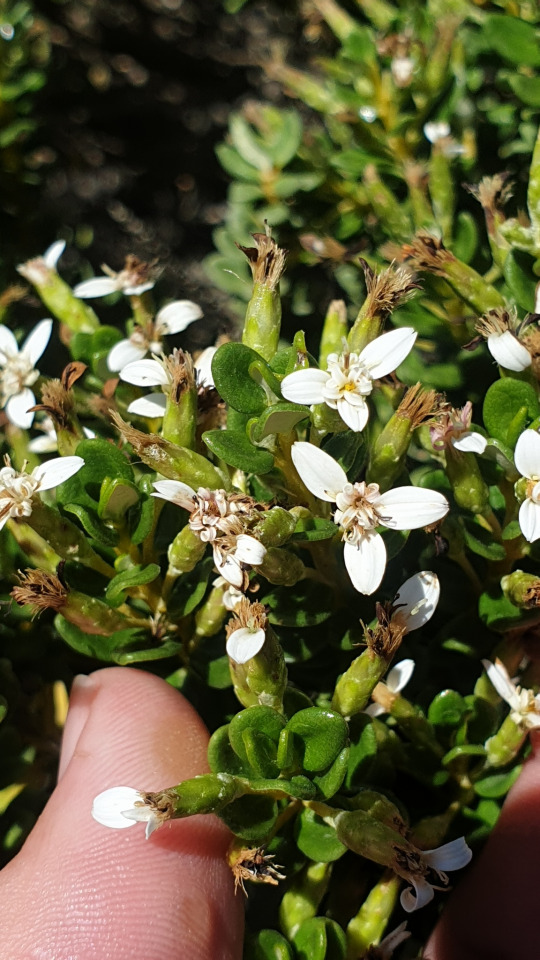

AKA Eurybia nummulariifolia, and Olearia hillii. The second part of the binomial means 'coin-leaved'.
(See also the frequently fossilised foraminiferan Nummulites. The Ancient Egyptians used the fossils as coins, and the Pyramids were built from nummulitic limestone. In 1913, naturalist Randolph Kirkpatrick published a book, The Nummulosphere, claiming that ALL rocks were accumulations of fossil forams like Nummulites.)
A shrub on the highest point of the Tasman moraine, with a few icebergs floating in the meltwater lake behind it.
Found in the higher parts of the North Island, but more widely distributed on the South.
Aoraki / Mt Cook, Aotearoa New Zealand.
0 notes
Text
Annals of Improbable Research, i premiati dell'IgNobel per il 2023

IgNobel 2023, i vincitori dei premi più pazzi della scienza tra geologi che leccano le pietre e sessualità delle acciughe. E ancora, wc superintelligenti, persone che parlano al contrario, ragni morti robotici… Siamo arrivati alla trentatreesima edizione. Non possono vantare la storia e il pregio dei Nobel, ma di sicuro anche loro, gli IgNobel sono destinati a una certa popolarità. Il motto rimane sempre quello: la scienza che prima fa ridere e poi pensare. Bizzarro è tutto quello che ruota intorno ai popolari premi che precedono di qualche giorno i Nobel. Per dire, quest’anno, durante la cerimonia ci sono state interessanti lecture da parte di esperti e ricercatori della durata di 24 secondi e di 7 parole. Ma a tener banco durante la cerimonia dell’Annals of Improbable Research ideata da Marc Abrahams e sono stati, soprattutto, loro, i premi. E qual è la migliore ricerca improbabile premiata nel 2023? Ve la mostriamo di seguito (spoiler, quest’anno, purtroppo, l’Italia torna a casa a mani vuote a differenza delle precedenti edizioni). Geologia gourmet Jan Zalasiewicz arriva dalla University of Leicester, nel Regno Unito, e si incassa il premio per Polonia e Regno Unito per aver spiegato sapientemente “perché ai geologi piace leccare le rocce”. Raccontava infatti egli stesso nel 2017 in un articolo dal titolo abbastanza eloquente (Eating fossils) come leccare le rocce - ma all’occasione anche bruciarle, bollirle - fosse una parte, forse un po’ datata e non esente da rischi, di un vecchio modo di fare ricerca, uno strumento analitico scrive. Zalasiewicz ricorda come leccare una roccia consenta subito di vedere in maniera più chiara di cosa è fatta, mettendone in luce le caratteristiche, magari anche assaporandola. Lo ha fatto egli stesso, ricorda, arrivando alla scoperta di uno splendido nummulite (un protozoo fossile). Ma lo hanno fatto anche i grandi del passato, come Giovanni Arduino, il padre della stratigrafia, e, a quanto pare, anche degustatore di rocce. Letteratura, vince l’arte della ripetizione Premio internazionale per la letteratura, con Chris Moulin, Nicole Bell, Merita Turunen, Arina Baharin, e Akira O’Connor che se lo aggiudicano con la seguente motivazione: “per lo studio delle sensazioni che le persone provano quando ripetono una sola parola molte, molte, molte, molte, molte, molte, molte volte”. Questo team franco-malesiano-britannico-finlandese ha infatti studiato le sensazione di alcuni partecipanti chiamati a scrivere e riscrivere determinate parole, fino al punto da trovarle strane, come mai viste o sentite (in un fenomeno chiamato, in contrapposizione al déjà vu, come jamais vu, a indicare la sensazione di estraneità di qualcosa di noto però). Un fenomeno che si ottiene, pare, dopo aver scritto la stessa parola trenta volte o per un minuto e che stimola riflessioni su ortografia e significati. E che è più frequente in chi sperimenta anche il suo opposto. Ingegneria ai ragni robot, morti Si premia la necrobiotica, sì avete capito bene: come suggerisce il nome è una branca della robotica (se così potremmo dire) che utilizza parti morti di animali. In questo caso ragni: il team di Te Faye Yap, Zhen Liu, Anoop Rajappan, Trevor Shimokusu, e Daniel Preston, che arriva da India, Cina, Malesia, e Usa, si è aggiudicato il premio per aver “rianimato ragni morti come strumenti meccanici da presa”. D’altronde, spiegano, senza creare ex novo, si può sfruttare quanto presente in natura: e così, un ragno morto, con il suo fantastico sistema di locomozione, può anche diventare un abile strumento da presa, capace di acciuffare oggetti delicati e dalle strane geometrie, spiegano i ricercatori nelle presentazioni ufficiali. Super-smart toilet per la salute pubblica Un unico vincitore in questa categoria è il sudcoreano Seung-min Park della Stanford University School of Medicine, premiato per lavorare da anni alla messa a punto di un wc da far impallidire i famosissimi wc tecnologi giapponesi. Cita la motivazione ufficiale: “per aver ideato la toilet di Stanford, un dispositivo che utilizza una gran varietà di tecnologie – tra cui una striscia reattiva per l’analisi delle urine, un sistema di visione artificiale per l’analisi della defecazione, un sensore per l’impronta anale abbinato a una telecamera di identificazione e un sistema di telecomunicazioni – per monitorare e analizzare rapidamente le sostanze che espellono gli esseri umani”. Park è convinto infatti che i wc digitali siano uno strumento preziosissimo per l’analisi della salute delle persone a distanza, che potrebbe essere utile persino nelle sperimentazioni cliniche. E, ovviamente, promette, anche per l’identificazione di eventuali malattie. Premio di comunicazione per chi parla al contrario Ci sono persone capaci di parlare al contrario, leggendo le parole dalla coda alla testa. Sono casi senza dubbio particolari, e possono diventare oggetto di studio. Lo sono stati: il team premiato nella sezione comunicazione degli IgNobel ha infatti studiato le caratteristiche neurocognitive di due persone capaci di pronunciare le parole leggendo i fonemi al contrario. E qualche differenza, raccontano, è stata trovata in alcune regioni cerebrali, sia per quanto riguarda una maggiore connettività che materia grigia. I premiati sono María José Torres-Prioris, Diana López-Barroso, Estela Càmara, Sol Fittipaldi, Lucas Sedeño, Agustín Ibáñez, Marcelo Berthier, e Adolfo García e arrivano da Argentina, Colombia, Spagna, Usa, Cina e Cile. La medicina ai peli del naso Il bello degli IgNobel è che permettono di rispondere a domande che non ci saremmo forse mai fatti. Per dirne una, il numero dei peli del naso nelle narici è lo stesso? Christine Pham, Bobak Hedayati, Kiana Hashemi, Ella Csuka, Tiana Mamaghani, Margit Juhasz, Jamie Wikenheiser, e Natasha Mesinkovska sono stati premiati proprio per aver risposto a questa annosa questione, conducendo un’analisi sui cadaveri. A quanto pare sì, o meglio quasi: in media ce ne sono 120 a sinistra e 122 a destra. Lo studio però serviva soprattutto a ottenere informazioni utili per i pazienti con alopecia areata, che riportano più allergie e infezioni respiratorie associate alla perdita di peli nel naso. Il premio va a , Canada, Macedonia, Iran e Vietnam. Nutrizione “elettrica” Non fate mai quello che Homei Miyashita e Hiromi Nakamura proponevano ormai diversi anni fa. Il lavoro ripescato per la sezione nutrizione quest’anno agli IgNobel arriva direttamente dal 2011 ed esplora il mondo del gusto aumentato grazie all’elettricità. La motivazione ufficiale per il premio al Giappone cita: “per esperimenti per determinare come le bacchette e le cannucce elettrificate possono cambiare il gusto del cibo”. I ricercatori infatti spiegavano come fosse possibile utilizzare il gusto elettrico e dei sensori per aumentare l’esperienza del gusto, percependo qualcosa che sarebbe impossibile forse percepire (e magari meglio così). Premio per l’educazione alla noia A scuola può capitare anche di annoiarsi. Ma lungi dall’essere un’emozione da accantonare, anche la noia va studiata. Lo hanno fatto Katy Tam, Cyanea Poon, Victoria Hui, Wijnand van Tilburg, Christy Wong, Vivian Kwong, Gigi Yuen, e Christian Chan, che sono stati premiati proprio per questo. I ricercatori hanno scoperto che anche solo aspettarsi che una lezione sarà noiosa la renderà noiosa, ma anche che se gli studenti vedono i loro insegnanti annoiati o li percepiscono come tali saranno meno motivati. Insegnanti, è il vostro momento, fate tesoro di questo IgNobel. Dividono il premio Canada, Cina, Regno Unito, Paesi Bassi, Irlanda, Usa e Giappone. Psicologia, le dinamiche dello sguardo verso l’alto Va agli Usa e arriva niente meno che dalla fine degli anni Sessanta il lavoro che si aggiudica il premio per la psicologia. La motivazione cita: “per esperimenti su una strada cittadina per vedere quanti passanti si fermano a guardare verso l'alto quando vedono degli estranei che guardano in alto”. Quanti più lo fanno, scrivevano, tanti più si fermeranno e lo faranno. Premio a Stanley Milgram, Leonard Bickman, e Lawrence Berkowitz. Fisica, quelle strane relazioni tra correnti e sesso delle acciughe
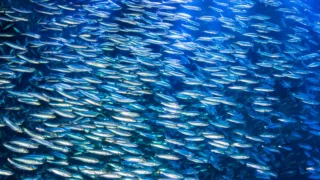
Ciliegina sulla torta, il premio della fisica va a un folto gruppo di ricercatori per “per aver misurato quanto la miscelazione dell'acqua dell'oceano è influenzata dall’attività sessuale delle acciughe”. Radunandosi in massa durante la stagione riproduttiva, scrivevano gli autori, possono infatti generare delle turbolenze, innescando la miscelazione delle acque, potenzialmente influenzando anche la crescita del fitoplancton. Premiati Bieito Fernández Castro, Marian Peña, Enrique Nogueira, Miguel Gilcoto, Esperanza Broullón, Antonio Comesaña, Damien Bouffard, Alberto C. Naveira Garabato, e Beatriz Mouriño-Carballido, provenienti da Spagna, Galizia, Francia, Svizzera e Regno Unito. Read the full article
#acciughe#annalsofimprobableresearch#antiNobel#ignobel#necrobiotica#ortografia#pelidelnaso#ragnirobot
0 notes
Photo








J’ai passé quelques jours chez Christine à Pau.
La très jolie petite ville de Salies-de-Béarn. Le Musée du Sel;
- Nummulites
- cristal de calcite
- pince et céphalothorax d’un crabe de l’éocène (je crois), Xanthopsis dufourii, fossile des Landes
- cristal de gypse
- Nipadites, noix de coco fossile (éocène ? oligocène ?) trouvé près de Pau.
- le reste montre comment les gens de la ville traitaient le sel : ils allaient à certaines périodes récupérer le plus d’eau possible à la source d’eau salée au centre de la bourgade. Ils gardaient cette eau dans des puits privés. On faisait ensuite bouillir cette eau, on récupérait ce qui flottait avec des râteaux, on le disposait sur des draps au dessus de la cheminée où ça s’évaporait. En gros !
#salies#salies-de-béarn#béarn#sel#musée du sel#fossile#êre tertiaire#éocène#oligocène#nummulite#calcite#cristal#cristaux#gypse#crabe#gan#landes#xanthopsis#noix de coco#nipadites#salant
2 notes
·
View notes
Text
All my ammonites plus a Lopha and a Belemnite. As a kid I was told they were related, as in "The Belemnite curved into the Lopha which curved into the ammonite." Don't think that is true, especially considering Lopha is a bivalve fossil. Also a nummulite, which, to this day, I don't really understand them as the organism they were lol.

#the two big ones are palm sized#ammonite#paleontology#paleobiology#fossils#belemnite#lopha sp.#hobby#collection#metalifer ammonites#hematite ammonites#nummulite#sectioned ammonite
41 notes
·
View notes
Photo






How cool are these fossil coins!
From Niue, and alas silly expensive because they make them in precious metals.
80 notes
·
View notes
Video
instagram
Whole field covered with Nummulites fossils
#nummulite#nummulites#geology#fossil#foram#foraminifera#video#instagram#the earth story#fossilfriday#iran
75 notes
·
View notes
Photo

Fossil Foraminifera Nummulites laevigatus – Eocene Cuisian Stage, Aisne Valley France – Genuine with COA
Presenting an exquisite fossil specimen of the foraminifera Nummulites laevigatus, a prehistoric marine microorganism from the Eocene epoch. This fossil dates specifically to the Cuisian stage and was discovered in the Aisne Valley near Soissons, France – an area renowned for its well-preserved Paleogene fossils.
Nummulites are large, lenticular foraminifera that thrived in warm shallow seas around 50 million years ago. Their intricate calcareous shells, composed of numerous chambers, are highly prized by both amateur and professional collectors for their scientific importance and distinctive, coin-like appearance (from which the genus gets its name, derived from "nummulus," Latin for "little coin").
Item Details:
Species: Nummulites laevigatus (sometimes referred to as laengryus)
Age: Eocene Epoch, Cuisian stage (~50 million years old)
Location Found: Aisne Valley, Soissons, France
Condition: 100% genuine fossil specimen with exceptional preservation
Scale: Scale cube in photo is 1cm – please refer to image for full size
Photography: What you see is what you get – the exact specimen pictured is the one you will receive
Packaging: Secure and protective packaging
This fossil is an excellent addition to any collection of microfossils or paleontological specimens and is ideal for educational use, display, or gifting. It comes with a Certificate of Authenticity to verify its provenance and authenticity.
We take pride in selecting only high-quality, well-preserved fossils. Each item is handpicked to ensure it meets our rigorous standards.
#Nummulites fossil#foraminifera fossil#Eocene fossil#Cuisian stage#Aisne Valley fossil#Soissons fossil#French fossil#microfossil#marine fossil#fossil specimen#genuine fossil#fossil with certificate#fossil from France#fossil for collection#paleontology#natural history
0 notes
Text
I learned one of the most interesting histories of the pyramids: they have millions of years old fossils 🐚


That’s right. So many of the building blocks of the pyramids still contain fossils from the ancient Tethys sea millions of years before the pyramids were built


Bilobates, Brachiopods, nummulites and more fossils 🐚 You can see them in almost every stone of the big pyramid of Khofo.
Tiny but seen to a keen eye.
I was extremely happy to learn this because I have been fascinated by fossils and their abundance in so many parts of Cairo.
I’m talking fossils that outlived the ancient Tethys sea that covered what is now north of Africa millions of years ago




This makes me genuinely believe they were aware of what this land once was.
They made a pyramid of the remnants of an ancient sea 🌊

I’m a storyteller with passion to earths and stories, you can follow me here and on instagram: @somewhereincairo
#egypt#ancient#desert#fossils#nature#landscape#history#photography#africa#sea#cairo#giza#artists on tumblr#geology#paleontology
202 notes
·
View notes
Photo

In the 1910s, Randolph Kirkpatrick was a British marine biologist and naturalist who was the head of the invertebrate collection at the British Museum of Natural History. He was dominated by one theory of his: he believed the entire planet was composed of Nummulites, an extinct fossil of a single-celled organism. Now, stop and think about that, how could the entire planet, including the rocks set down by molten lava, actually just be dead clam-shaped sea fossils? But “Crazy Old Randolph Kirkpatrick” (as he was known) studied all the rocks you can find, and what did he see? Nummulites! The entire world were just endless Nummulites.
He even self-published a manuscript of his about his theory of the Nummulosphere, featuring Poseidon, holding a Nummulite, on an entire earth that was just one big Nummulite.

Everyone laughed at “Crazy Old Randolph Kirkpatrick” and thought he was a certifiable nut, until the day of his death.
Here’s the part where it gets interesting. As a marine biologist and expert on sponges, Crazy Old Randolph published endless theories (when he wasn’t talking about the Nummulite thing) about how sponges in New Guinea had coral-like skeletons that looked like beautiful glasswork, that were essentially living undersea glass. Nobody really paid attention to him about this, though, because it sounded too wild, and besides, he had a bad reputation from the Nummulites as a weird old crank.

However...six decades later, glass sponges were in fact, discovered, more or less as Kirkpatrick described at the turn of the century. Meaning that long after his death, “Crazy Old Randolph Kirkpatrick” was right all along.
As Stephen Jay Gould, who wrote about Randolph Kirkpatrick, said:

147 notes
·
View notes
Photo

With precious beauties like this we really should rename ourselves Amsterdam Prehistoric Watches. There aren't many of these around, and even less with uncracked surface. The only time I would wear a Fossil watch 😋#amsterdamvintagewatches #rolex #vintagerolex #rolexdaydate #18038 #18238 #rolex18238 #stonedial #rolexstonedial #daydatefossil #rolexfossil #fossildial #vintagerolex #jurassicpark #rolexjurassicpark #nummulite #foraminifera (bij Amsterdam Vintage Watches) https://www.instagram.com/p/CfI-vYUtqtW/?igshid=NGJjMDIxMWI=
#amsterdamvintagewatches#rolex#vintagerolex#rolexdaydate#18038#18238#rolex18238#stonedial#rolexstonedial#daydatefossil#rolexfossil#fossildial#jurassicpark#rolexjurassicpark#nummulite#foraminifera
6 notes
·
View notes
Text
Foraminifera: Introduction and anatomy
There’s a lot more to palaeontology than just dinosaurs. I’m sure you’re familiar with fossil mammals like mammoths and sabre-tooths. Everyone loves fossil fish like Dunkleosteus and Megalodon. Fossil invertebrates, like trilobites or ammonites, are some of the most famous fossils of all time. And fossil plants are all over the place, from petrified wood to leaf impressions in coal. But have you ever thought about fossil microorganisms?

(Image: Single-celled organisms like this foraminifera are among the most common organisms today, but the vast majority are microscopically small. [Source])
Microbes are everywhere on Earth today, and they have been everywhere on Earth for seemingly as long as life has existed. They live in practically every environment—but their small size and soft bodies have meant that fossils of them are very rare.
Well, almost all of them, that is. One particular group of single-celled organisms is among the best-studied groups in the entire fossil record, having a highly detailed fossil record stretching back for over 540 million years. These are the hard-shelled foraminifera.
I’ve become enamoured with this neat little group of protists lately. But I’ve been really disappointed with a lot that’s been written about them. For despite being some of the most interesting and geologically famous protists, there has been very little written about them that is accessible to anyone who doesn’t already know a lot about them. I’d like to change that.
What are foraminifera?
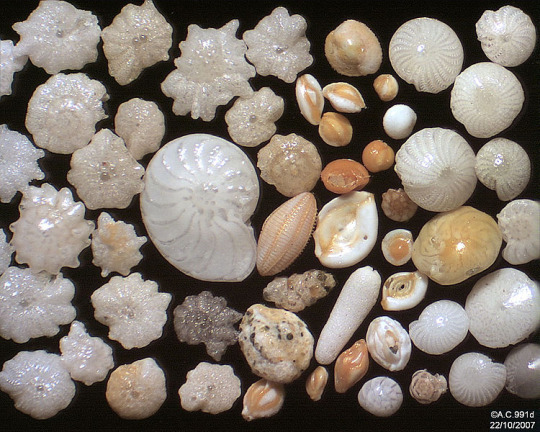
(Image: An assortment of foraminifera shells, with a huge variety of shapes and sizes. More on that later... [Source])
Foraminifera (literally meaning “opening bearers”), or “forams” as they are commonly called, are a group of single-celled eukaryotes. In other words, they have a nucleus (or often multiple of them), and they have mitochondria that act as (say it with me) the powerhouse of the cell. Most forams consume smaller microorganisms as food; however, some are capable of utilising dissolved organic carbon, and many groups have convergently evolved endosymbiotic relationships with photosynthetic algae, including rhodophytes, chlorophytes, and dinoflagellates. In fact, certain foraminifera can extract the chloroplasts from algae they consume and incorporate them into their own cells to do photosynthesis! These don’t last forever, though, and the forams eventually digest the chloroplasts. Some other foraminifera actually actively predate on and kill small animals—an amazing feat for a single-celled organism!
Some of the most famous foraminifera are the planktonic forms that float within the water column; however, the vast majority of forams are benthic organisms. These include forms from shallow water to forms found at the very deepest point of the ocean. Though some benthic species live only above the sediment-water interface and others live only interstitially, most benthic forams are not confined to one mode of life and may move between layers of the community in order to seek out food. Some of these forms can even survive without oxygen for extended periods! This allows them to live in conditions that would kill many other organisms.
A few species of forams have been identified from freshwater environments, and one study presented molecular evidence suggesting foraminifera may be widespread in soils, although no actual forams have been found from soils yet. It seems that there might be a lot of diversity even among living forams that we still have yet to uncover.
Anatomy
Of all single-celled organisms, why is it that foraminifera have such a good fossil record? The answer lies in the hard shell of many species, known as a test.
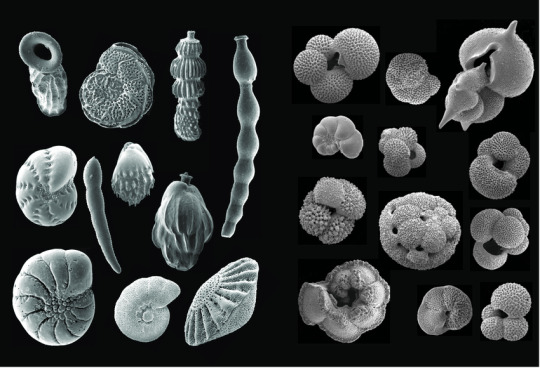
(Image: A variety of test shapes in different foraminifera groups, viewed with a scanning electron microscope. They include may shapes—coiled, glob-shaped, linear, egglike, and more. There are many other shapes of tests that aren’t shown here—like spiralled, branched, disc-like, and more. All of these tests are calcareous. [Source])
These tests are not simply external structures within which foraminifera live; rather, the test is actually within the cell membrane. Although the soft parts of the foraminiferal cell are almost never preserved in the fossil record, modern species of forams have helped us learn a lot about their anatomy. Extending from the opening(s) of the test are pseudopodia, fingerlike extensions of the cell membrane. As the most prominent extensions of the cell outside of the test, they serve a multitude of functions, including locomotion, feeding, agglutinating the test, reproduction, respiration, and excretion. In many forms these pseudopodia extend in all directions through numerous tiny holes in the shell of the test. In other ways the foraminifera anatomically resemble typical single-celled eukaryotes, with nuclei and mitochondria. Some species have multiple nuclei within a single cell). During reproduction, some species of forams can even leave their shell behind entirely to undergo cell division.
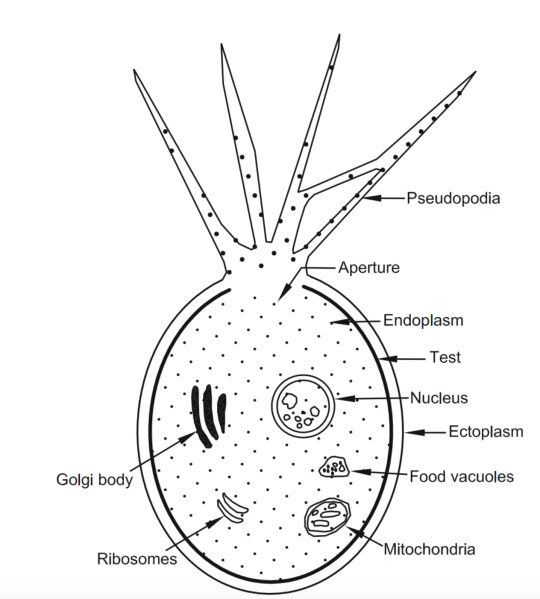
(Image: The anatomy of a foraminiferan. Note that the test is actually inside of the cell wall, but most of the cell materials are inside the test. The pseudopodia are the main thing that extend out of the aperture, or hole. This drawing is a unilocular, or single-chambered, foram.)
The most famous and diverse of these are foraminifera with calcareous tests. Calcareous means that they are made of calcium carbonate, and calcium carbonate takes two main forms: Calcite and aragonite. Calcite is a very common mineral in nature; it’s the stuff that makes up limestone, marble, antacids, coral skeletons, and more. And aragonite is a mineral with the same chemical composition as calcite, but with a different crystal structure. It’s found in the shells of many organisms, like snails. Both calcite and aragonite tests are found in foraminifera, and many species have their own particular composition and crystal structure.
Other forams have agglutinated tests: that is, tests that are made by collecting bits of sand and cementing them together, using either organic proteins or calcite to hold them together.
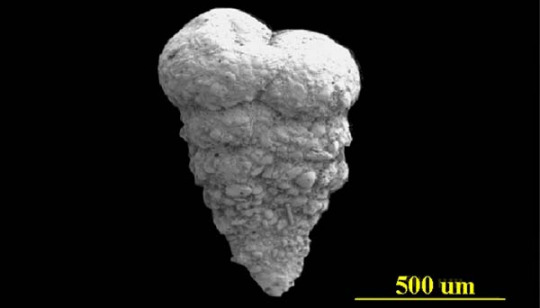
(Image: An agglutinated textulariid foram. Its test is made from sediment grains connected together. It looks a bit like an ice cream cone in shape, but rather than conical, it’s flat. And the top is sealed off. So really, it looks nothing like an ice cream cone. [Source])
Fewer still forams secrete tests of silica—the material that quartz and glass are made of. Others have softer tests made completely from proteins and other organic material. Even rarer are foraminifera which entirely lack tests and were until recently considered to be amoebae; these species likely secondarily lost the test.
Test composition appears to be pretty fluid in foram evolution. In the family tree of foraminifera, it seems that calcite tests evolved multiple times, and so did agglutinated tests. In some cases it looks like they might have even gone from calcite tests to agglutinated tests.
Test shape is also highly diverse within foraminifera. The simplest shape of test are the unilocular, or single-chambered, forms; however, unilocular forms may also have more complex chamber shapes, including spiraled tubes outwardly resembling snail shells. Unilocular forms are found in several groups of forams. The earliest foraminifera were probably all unilocular, and modern unilocular forams probably form a paraphyletic “grade” rather than a true branch of the tree of life. Single-chambered foraminifera probably make up the bulk of forams alive today, but many of these species remained undiscovered and unnamed.
Although unilocular forams are frequently considered the “simplest” forams, they also include some of the most bizarre protists, the xenophyophores. These are my favourite group of foraminifera, and the reason is, I think, pretty clear—they’re enormous. Like, I mean, the largest ones can get up to 20cm/8in across! These are the largest known single-celled organisms on the planet. All of the known species live on the floor of the deep ocean, where they filter-feed.

(Image: A xenophyophore, a giant, single-celled foraminifera. It looks a bit like a sponge, which is what it was once mistaken for. [Source])
Most named species of forams, however, are multilocular, having multiple chambers within their tests. The tests of the most well-known forms superficially resemble the shells of ammonites or nautili. In fact, the earliest scientific descriptions of foraminifera described them as being tiny cephalopods! The septa (internal dividing walls) of foraminiferal tests have holes that allow for the cytoplasm to flow between compartments, so that the cell can make use of all of the available space within the test. These openings—or foramina—also provided the name for the group: When initially thought to be cephalopods, they could be distinguished from all other coiled forms by the foramina between compartments.
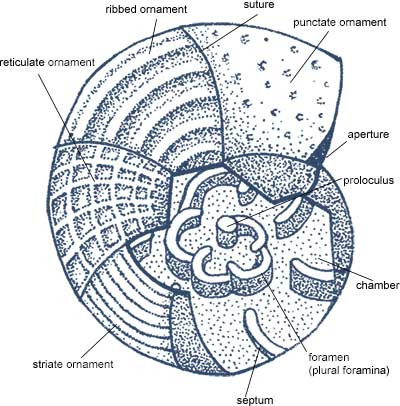
(Image: Cross-sectional diagram of a coiled, multichambered foraminifera. It does look a lot like a nautilus, and even has multiple chambers in its shell. However, unlike nautili, these chambers are connected by holes. [Source])
Not all multilocular foraminifera are coiled, however; many form more linear or globular shapes. Some are even star-shaped! Giants in their own right are found among the multilocular forms: the rotaliid genus Nummulites, though now smaller, has extinct representatives that could reach 15cm across, with up to 4300 distinct compartments. These lens-shaped forams make up the limestone that was used to build the Great Pyramids in Giza.
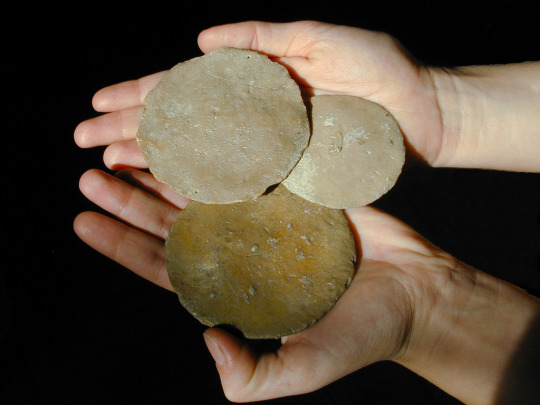
(Image: Fossil Nummulites shells being held by a human. They kind of look like pancakes, and are about 15cm/6in in diametre. Though you can’t see it here, they are actually coiled shells. [Source])
This post is the first in a multi-part series covering foraminifera—their anatomy, reproduction, evolutionary history, major groups, and geological applications. Later parts will be linked here, or check the “Foraminifera” tag on my blog!
#palaeontology#palaeoblr#foraminifera#biology#marine biology#microbiology#protists#long post#sunday long posts
275 notes
·
View notes
Text



Here, we have some different species of foraminiferans. Globigerinoides sacculifer (planktic), Nummulites (benthic) and Liebusella (benthic).
Forams are a type of protist (single-celled organism) with shells that are composed of calcium carbonate (calcite or aragonite), silica (sand particles) or organic material.
Some species are planktic, meaning they live floating in the water while others are benthic, meaning that they live on the sea floor or among corals.
Foram fossils can be used in biostratigraphy to give an idea of the relative age of the rocks they are found in. They are also used in Paleoecology to describe the environmental conditions of the area they once inhabited.
#geology#science#studyblr#paleontology#fossils#microscope#marine#biology#paleoecology#paleoclimatology#learning#college#ocean
74 notes
·
View notes
Text

#ostrea #nummulites #assilina #geology #paleontology #fossils #fieldtrip
Nummulit bank
0 notes